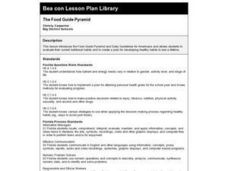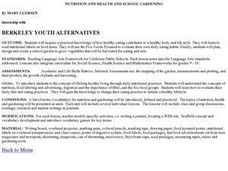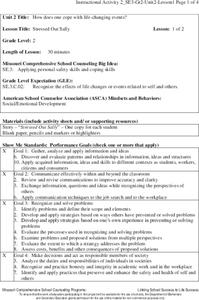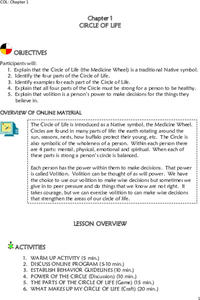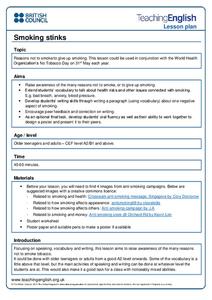Curated OER
The Food Guide Pyramid - Daily Food Journals
Students examine the Food Guide Pyramid, then keep daily food journals. They evaluate their current nutritional habits and create plans for developing healthier eating habits.
Curated OER
Nutrition and Health and School Gardening
Students examine how healthy eating contributes to a healthy body and life style. They read nutritional labels on food items. They use the Five Foods Pyramid to evaluate their own eating habits. They plan, design, and create a school...
Curated OER
Eating for Health
Students examine their family's eating habits. In this adult health lesson, students discuss changes they plan to make in their family. They observe how hopscotch is played and try to do this at home.
Curated OER
Rate Your Family's Plate
Students examine their family's eating habits. In this adult health lesson, students share what they think from the survey facts presented to them. They set a goal for their family's health.
Curated OER
Sometimes And All the Time Foods
Students utilize a picture of a lunch box and draw pictures of healthy food choices with which to fill it. The reasons for their choices of particular foods are discussed and the concepts of sometimes foods and all the time foods are...
Curated OER
First Place Foods
First graders identify healthy foods. In this nutrition lesson plan, 1st graders create a Venn diagram to compare and contrast healthy foods. Students place foods in the proper circle.
Curated OER
Taking Care of a Baby
Students are introduced to the basics of human development and the critical role of parents in taking care of a newborn.
Curated OER
Taking Care of a Baby
Pupils explore the basics of human development and the critical role of parents in taking care of a newborn.
Curated OER
The ABC's of Breakfast
Students identify the food group of various culturally diverse breakfast foods and discuss the importance of eating a healthy, well-balanced breakfast every morning. They then try different foods that begin with the letter A, B and C and...
Council for the Curriculum, Examinations and Assessment
Health and the Whole Person
The first lesson of the unit introduces class members to the social, physical, emotional, cognitive, and spiritual constituent elements of health and the need for balance among these elements. Class members used the provided assessment...
Council for the Curriculum, Examinations and Assessment
Health and the Whole Person
To begin the second year of a health and wellness course, class members review the aspects of social, physical, emotional, cognitive, and spiritual health investigated the previous year. After completing the provided self-assessment...
Missouri Department of Elementary
Are You Balanced?
Balance scales create a strong visual of how an individual prioritizes one's self alongside their commitments to the community, school, and home. Scholars complete a graphic organizer then discuss their findings with their peers. A...
Missouri Department of Elementary
Stressed Out Sally
Life changes may cause stress. Here, scholars identify stressful situations in a peer's life and offer coping skills to make for a better day. A short story, "Stressed Out Sally," provides pupils with a look inside a bad day. After...
Healthy Native Youth
Chapter 1: Circle of Life
Volition, or will-power, is the focus of a instructional activity that brings forth the Native symbol, the Circle of Life, to instill the importance of responsible decision-making. Scholars take part in six activities that empower them...
Missouri Department of Elementary
I’m Thumbody!
Positive and negative thinking is the focus of a lesson that boost self-awareness. Beginning with a whole-class discussion, scholars brainstorm what positive thinking looks and sounds like then compares and contrast the two types of...
Northern Ireland Curriculum
Self Concept
It may not be possible to have control over all aspects of life, but through the activities and discussions in this lesson class members learn different ways to cope with those areas over which they have little or no control.
Council for the Curriculum, Examinations and Assessment
Morals, Values, and Beliefs
What is integrity? What are the barriers that could keep a person from acting with integrity? How might these barriers be overcome? Class members tackle these questions as part of a course on Social, Physical, Emotional, Cognitive and...
British Council
Smoking Stinks
There are lots of good reasons not to smoke. Make sure your middle and high schoolers understand each and every one with a lesson plan that prompts them to read anti-smoking posters, note the main points, and write a short response on...
Council for the Curriculum, Examinations and Assessment
Feelings and Emotions
The focus of the second session in this SPECS unit is on learning how to identify, and then appropriately express and manage feelings.
University of Washington
Connecting Youth to Quality Health Information
Many teenagers don't have adequate access to health and nutrition information beyond a quick Internet search. Guide them into health advocacy and proficiency with a lesson focused on MedlinePlus as a reliable source for health...
Scholastic
Marijuana: Perception of Harm vs. Use
Many teenagers don't believe that marijuana is harmful, but if they do, it affects whether they use it or not. Analyze the relationship between what high school seniors believe about marijuana and their tendency to use it with a reading...
Centers for Disease Control and Prevention
Going SmokeFree Matters: Casinos
Everyone has the right to a smokefree workplace, but those who work in casinos are exposed to so much secondhand smoke that they can suffer the same ailments as heavy smokers themselves. Learn more about the effects of secondhand smoke,...
Twin Cities Medical Society
Should I Talk to My Kids about Vaping?
Enlist parents and guardians in an anti-vaping campaign with an infographic that offers suggestions for how to talk with their students about e-cigarettes and e-liquids. The visual includes information about the dangers of vaping as well...
Curated OER
Eating Healthy
Sixth graders record what they eat for an entire day. They use the Food Pyramid and determine whether or not they ate the recommended amounts and recommended foods. They write a plan of how they could improve their eating habits.


